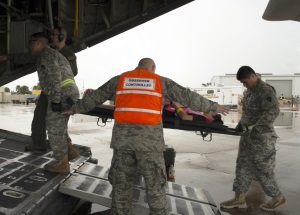Texas Guardsmen, local first responders exercise air and medical capabilities (1 of 4)
Story By: Sgt. Elizabeth Pena
Posted on: June 16, 2016
 Photo By Sgt. Elizabeth Pena | An Air Guardsman evaluates Texas Guardsmen on their transport of mock patients to the military aircraft during an evacuation exercise at the Valley International Airport in Harlingen, Texas, June 9, 2016. The Texas Division of Emergency Management along with the support of Texas Military Department and other state and local authorities conduct a state level hurricane-preparedness exercise June 1-9, 2016 across various Texas cities. The Texas Military Department practiced both general population and medical evacuation through embarkation hubs in the Rio Grande Valley. (Photo by U.S. Army National Guard Sgt. Elizabeth Pena/Released)
Photo By Sgt. Elizabeth Pena | An Air Guardsman evaluates Texas Guardsmen on their transport of mock patients to the military aircraft during an evacuation exercise at the Valley International Airport in Harlingen, Texas, June 9, 2016. The Texas Division of Emergency Management along with the support of Texas Military Department and other state and local authorities conduct a state level hurricane-preparedness exercise June 1-9, 2016 across various Texas cities. The Texas Military Department practiced both general population and medical evacuation through embarkation hubs in the Rio Grande Valley. (Photo by U.S. Army National Guard Sgt. Elizabeth Pena/Released)
HARLINGEN, Texas -- Just in time for hurricane season to begin, guardsmen from the Texas Army National Guard, Texas Air National Guard and Texas State Guard supported the Texas Division of Emergency Management with air and medevac capabilities during a state level hurricane preparedness exercise June 1-9, 2016, in the Lower Rio Grande Valley and across various other Texas cities.
“This exercise is the first of its kind in all of Texas and the U.S., other than the real life occurrence with Katrina and Louisiana,” said Tony Pena, state coordinator for Texas Department of Public Safety Emergency Management, Region 3. “This is an exercise that has been long overdue for the Rio Grande Valley coastal area.”
The mock “Hurricane Tejas” mirrored the unforgettable 1980 “Hurricane Alan” which was the worst of its kind sweeping through the Rio Grande Valley coast at 190 mph. The scenario estimated 1.1 million people to be evacuated out of the Lower Rio Grande Valley.
“Allen is the only storm in the Atlantic basin in recorded history to achieve wind speeds of 190 mph,” said Col. Tom Suelzer, director of operations for the Texas Air National Guard, and for the state, he serves as the Air Operations Center director. “Allen is a great model for this exercise because it became a Category 5 two times in its life, and steered a direct path to the Rio Grande Valley from way out in the gulf."
The Texas Military Department practiced both general population and medical evacuation through embarkation hubs at the Valley International Airport in Harlingen, June 9, 2016.
“The reason that this exercise is so important is it validates the Texas Division of Emergency Managements’ plan to employ the Texas Military Department in assisting local authorities to ensure a safe evacuation of the Texas citizens from the potential harm.” said Col Williams, Air Expeditionary Group Commander.
During the mock hurricane evacuation, Texas Air National Guard, active duty Air Force, Oklahoma Air National Guard set up a Disaster Aeromedical Staging Facility for patients that are being transported to a higher level of care through military aircraft. These patients are brought in from local medical facilities and high school in Harlingen, Texas.
“The Disaster Aeromedical Staging Facility can process up to 140 patients in 24 hours,” said Col. Tami Rougeau, Individual Mobilization Augmentee to the assistant director of operations of Headquarters Air Mobility Command Scott Air force Base, Illinois. “We will run two C-130s for four missions. Each mission will have approximately 35 patients. All patients that are identified to be moved by the state are processed here into the DASF and registered nurses, medical technicians, critical care docs and flight surgeons care for them."
The Texas State Guard provided numerous service members to role play evacuees needing medical attention. Commercial aircraft carried members of the community role playing as general population evacuees out of the lower Rio Grande Valley to the shelter locations in Dallas/Fort Worth International Airport, Dallas Love Field and also Austin Bergstrom International Airport.
“We have never had one where we do a full-scale evacuation of actual patients and/or general population,” said Pena. “So with the combination of military aircraft on one hand and civilian general population on the other hand, I personally believe it’s going very well.”
“This is my first time doing this type of training, said Air Force Staff Sgt. Alice Salazar-Sherman, a medical technician with the 88th Inpatients Operation Squadron, at the Wright Patterson Air Force Base, Ohio. “We are overcoming a lot of barriers. It has been fun to see what the Department of Defense can do. This training is extremely important to prepare for what the state expects and to see what the Disaster Aeromedical Staging Facility is prepared to handle.
Texas Guardsmen are trained and equipped with military capabilities to help stabilize and improve the situation in the wake of a natural and man-made disaster.
“Within the Texas Air National Guard and Texas Army National Guard our aviation and air mission skill sets are directly applicable to domestic air operations,” said Suelzer. “The mission of coordinating a large aviation response naturally falls onto the Texas Military Department.”
The Atlantic Hurricane season runs from June 1 – Nov. 31, 2016.
This is 1 of 4 Texas Hurricane Preparedness)